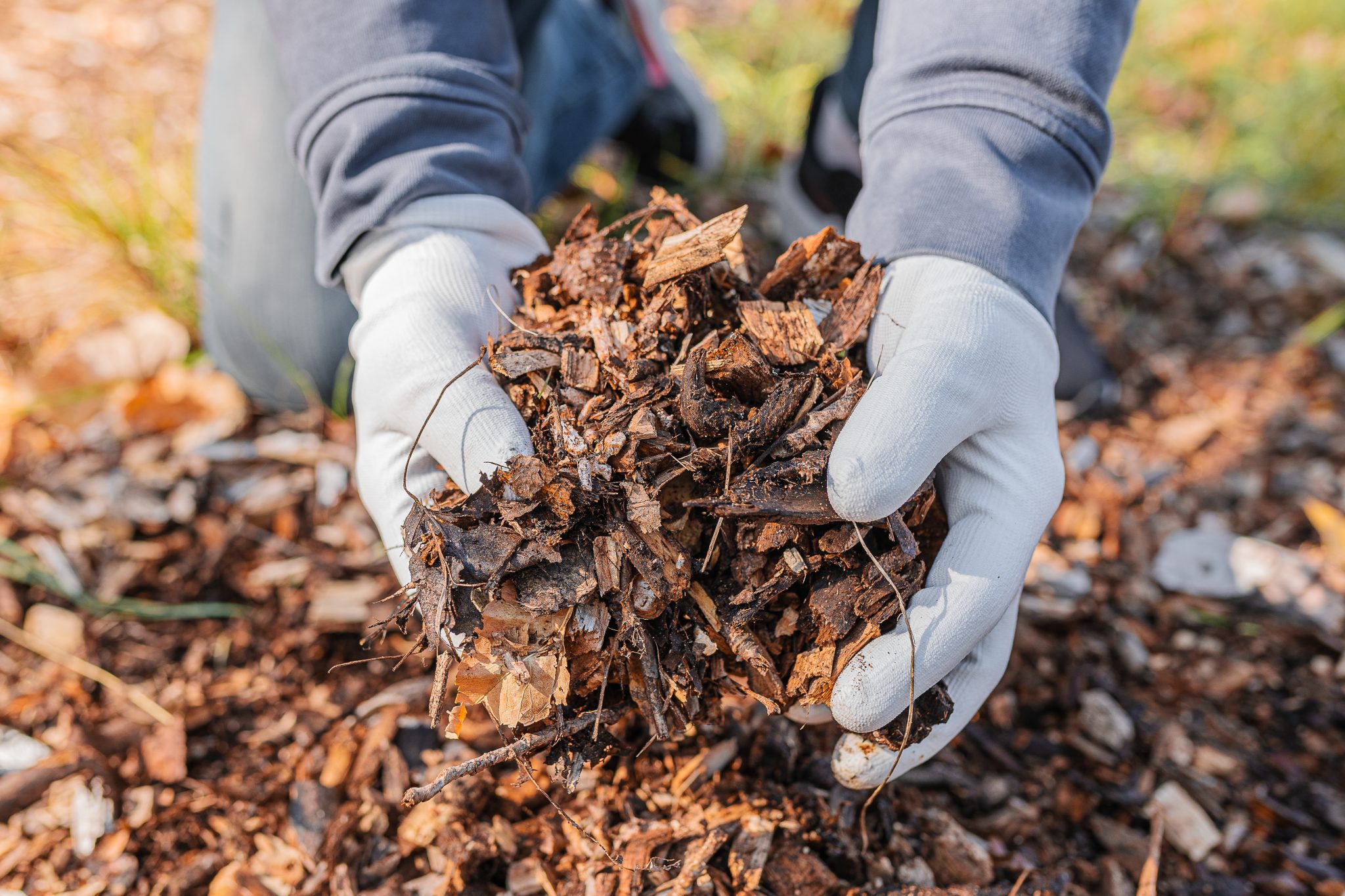Landscaping

Nature mulches plants with fallen leaves and other organic materials. Mulching, as practiced by gardeners, is merely an adaptation of this natural process.
Advantages of Mulching
Adding a layer of mulch around trees, shrubs, and planted beds offers several advantages. The greatest of these is conservation of soil moisture. Water evaporation is greatly reduced when the soil is protected from the sun’s direct rays and moving air. Mulch also prevents rain from eroding and compacting the soil surface.
Another important advantage of mulch is the control of weeds. Mulch greatly reduces the germination of weed seeds and can smother existing weeds. As an additional weed control strategy, mulch can be used with a preemergence herbicide, which kills weeds before germination. It is especially important to mulch rather than cultivate around shallow-rooted plants, such as rhododendrons, azaleas, and camellias.
Controlling soil temperature is another plus with mulch. Lower and more uniform soil temperatures in summer favor root growth and beneficial bacterial activity in the soil. High summer temperatures may injure roots and soil microorganisms near the soil’s surface. In winter, mulch insulates the root zone, protects roots from frost penetration, and buffers against freeze-thaw cycles. Winter mulch also prevents soil moisture from freezing, thereby becoming unavailable to evergreen plants.
Organic matter used as a mulch can improve soil structure, drainage, and aeration. As it decays, the organic mulch material becomes incorporated into the topsoil. Decaying mulch adds nutrients to the soil.
Mulching material, such as pine bark or pine needles, improves the garden’s appearance. It is valuable for covering beds near the house or in areas where neatness is important. Mulch can replace grass or groundcovers in areas that are difficult to mow or maintain. Mulching around trees and shrubs can prevent plant damage from mowers and trimmers.
Disadvantages of Mulching
Mulching has a few disadvantages. First, the cost of some materials can be a drawback to large-scale mulching. Some mulches are also not readily available. If large quantities are required, buying bulk loads of mulch is less expensive than buying mulch by the bag.
Sawdust and wood chip mulch have a high carbon content and can remove nitrogen from the soil. This is easily corrected by using additional nitrogen fertilizer.
Heavy mulching over years results in a mat of mulch covering the crown area of the plants. This can result in crown and root damage to plants. Rake old mulch to thin and break apart matted layers before applying a new mulch layer.
Avoid piling excessive mulch at the trunk of trees. This volcano mulching causes rot by holding moisture against the trunk.
Materials for Mulching
Rotted Manure. Apply 1 to 2 inches. May contain weed seeds. Should be thoroughly composted to prevent burning plants and minimize weeds sprouting.
Wood Chips. Apply 2 to 3 inches. Well-rotted materials are preferred. Wood chips decompose slowly. Chips can be used fresh if additional nitrogen fertilizer is added to the soil at a rate of 1 pound of fertilizer per 100 square feet. Keep away from building foundations, as wood chips can encourage termites.
Pine Bark. Apply 2 to 3 inches. Bark is ground and packaged commercially and can be found in various sizes. Pine bark is an attractive, dark-colored mulch in the landscape.
Pine Needles. Apply 3 to 6 inches. Pine needles will not mat down, are fairly durable, and allow good water and air penetration into the soil. Great for winter protection on perennials because of its nonmatting quality.
Compost. Apply 2 to 3 inches. Compost will slowly release nutrients into the soil for plant uptake.
Whole Tree Leaves. Apply 3 to 6 inches. Leaves are an excellent source of humus. They rot rapidly and are relatively high in nutrients. They are not recommended for herbaceous perennials.
Shredded Tree Leaves. Apply 2 to 3 inches. Shredded oak leaves as a mulch are especially valuable around acid-loving plants, such as azaleas, camellias, and rhododendrons. Shredded tree leaves are less prone to matting than whole leaves.
Grass Clippings. Apply 1 to 2 inches. Grass clippings tend to mat and can repel water if they dry out. They should not be applied deeper than 2 inches. This material is high in nitrogen. Mixing grass clippings with other mulch materials will add nitrogen while preventing matting. Do not use grass clippings from a lawn that has been treated with a weed killer.
Gravel. Apply 1 to 2 inches. Limited use but particularly good for rock garden plantings.
Stone Chips. Apply 1 to 2 inches. Stone chips are extremely durable. They hold down weeds but do not supply plant nutrients or humus.
Newspaper and Cardboard. Apply 1⁄2 to 1 inch. They should be covered with another mulch to improve appearance and prevent scattering.
Weed Fabrics. Landscape weed fabrics will allow water and air to penetrate the soil. They will prevent most weeds, but grasses may grow through the fabric. They can be covered with another mulch to improve appearance.
 Revised by Kerry Smith, Outreach Programs Administrator, Horticulture, Auburn University. Written by J. David Williams, former Extension Horticulturist, Ronald L. Shumack, former Extension Horticulturist, and Sam Boring, former Regional Extension Agent, all with Auburn University.
Revised by Kerry Smith, Outreach Programs Administrator, Horticulture, Auburn University. Written by J. David Williams, former Extension Horticulturist, Ronald L. Shumack, former Extension Horticulturist, and Sam Boring, former Regional Extension Agent, all with Auburn University.
Revised April 2023, Mulches for the Home Landscape, ANR-0385

